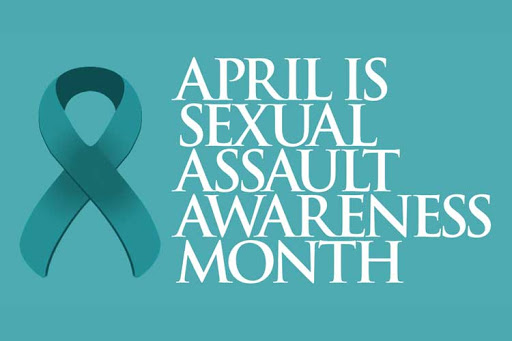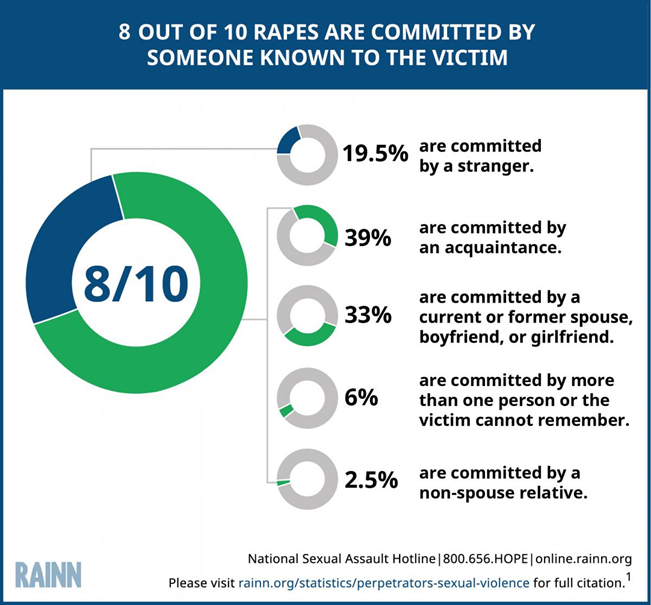
Every 92 seconds, an American is sexually assaulted; and every 9 minutes a child is sexually assulted.1 The numbers are heartbreaking. Each year, approximately 430,000 people living in the United States experience sexual assault, some of them children.2
Data from 2018 estimated that 734,630 people were raped (threatened, attempted, or completed) in the U.S. alone.3 The number of individuals who self-reported also increased but less people reported to the police.3
What is Sexual Assault and Who’s at Risk?

Rape, human trafficking, child sexual abuse, molestation, incest, sexual harassment, voyeurism, sexual exploitation, sexual violence; sexual assault is an umbrella term used to describe unwanted sexual contact of any kind.
Sexual assault can happen to anyone, regardless of how they dress, their sex, their race, or the choices they make.
Adults ages 18-34 are at a higher risk of rape and sexual assault (54%) than older adults ages 65+ (3%), adults ages 35-64 (28%), and children ages 12-17 (15%).2
One out of 6 women in America is a survivor of attempted or completed rape and Native American women are more likely to experience sexual assault when compared to women from other races.2 According to the 2016 National Institute of Justice study, Native American women are 2.5 times more likely to experience rape than white women, and more than half of Native American women have been sexually assaulted.4
What about Boys and Men?

In general, when we hear about sexual assault, we often think of women and girls. However, boys and men are impacted too.
I’ve heard stories about men who were ashamed of what they experienced, feeling as if their “manhood” or “masculinity” had been taken away from them. Feeling as if they were unable to speak up, not because people wouldn’t believe, but out of guilt and shame. Afraid that others would make fun of them or look down on them because of what they survived.
Three percent of American men have reported attempted or completed rape.2 With many survivors not reporting their incident, it is possible that the number of men who have actually experienced attempted or completed rape is much higher.
Long-Term Effects of Sexual Assault
A couple of years ago, I heard a woman sharing her experience as a survivor, and how the long-term impact she experienced when she was younger lingered into her adulthood. She described what it was like going to her annual women’s exam, and how she had to be sedated so that her gynecologist could conduct the exam.
The long-term effects of her experience are similar to other survivors.
- 94% of women who are raped experience symptoms of post-traumatic stress disorder (PTSD) during the two weeks following the rape.2,5
- 38% of victims of sexual violence experience work or school problems, which can include significant problems with a boss, coworker, or peer.2
- 84% of survivors who were victimized by an intimate partner experience professional or emotional issues, including moderate to severe distress, or increased problems at work or school.2
- 79% of survivors who were victimized by a family member, close friend or acquaintance experience professional or emotional issues, including moderate to severe distress, or increased problems at work or school.2
Signs of Abuse
People who experience sexual assault are likely to display signs of abuse.
Children
- Has difficulty walking or sitting
- Suddenly refuses to change for gym or to participate in physical activities
- Reports nightmares or bedwetting
- Experiences a sudden change in appetite
- Excessive talk about or knowledge of sexual topics
- Becomes pregnant or contracts an STD, particularly if under 14
- Runs away
- Reports sexual abuse by a parent or other adult caregiver
- Attaches very quickly to strangers or new adults in their environment
- Not wanting to be left alone with certain people
- Self-harming
- Overly compliant behavior
- Change in eating habits
- Change in mood or personality
Mercer County Children’s Advocacy Center, 2018; RAINN 2020
Men and Women
- Infidelity, sexual addiction.
- Complete disinterest in sex.
- Unusual sexual or sexualized behaviors.
- Porn addiction.
- Strong emotional reactions to the mention of sexual abuse of others.
- Depression, anxiety, self-harm.
- Abuse of alcohol or other drugs.
- Very protective behaviors towards children
Living Well, 2016
Every situation is different, and survivors may experience different signs of being abused. Older adults and those who are disabled also display signs of abuse.
Signs of an Abuser

Majority of people who experience sexual assault know their abuser. It is important to be on the lookout for common behaviors that abusers may have. Women can also be predators.
Adult – Child Abuse Signs
- Does not respect boundaries or listen when someone tells them “no”
- Engages in touching that a child or child’s parents/guardians have indicated is unwanted
- Tries to be a child’s friend rather than filling an adult role in the child’s life
- Does not seem to have age-appropriate relationships
- Talks with children about their personal problems or relationships
- Spends time alone with children outside of their role in the child’s life or makes up excuses to be alone with the child
- Expresses unusual interest in child’s sexual development, such as commenting on sexual characteristics or sexualizing normal behaviors
- Gives a child gifts without occasion or reason
- Spends a lot of time with your child or another child you know
- Restricts a child’s access to other adults
Adult – Adult Abuse Signs
- Restraining partner against their will during sex
- Acting out fantasies where the partner is helpless
- Initiating sex when the partner is asleep
- Demanding sex
- Aggressive or violent
- Isolates survivor
- Emotionally volatile
- Displays signs of jealousy
- Controlling
- Cruel to animals and children
Speaking Up and Seeking Help
Although less people are reporting their experience to police, more people are speaking up about what they’ve endured.
If you are a survivor of sexual assault, it’s never too late to speak up and share your story. It’s also never too late to get help.
- Speak to someone you trust about what happened
- Join a support group
- Spend time with others
- Find a counselor
- Support other survivors
Resources:
RAINN (Rape, Abuse & Incest National Network)
National Sexual Assault Hotline
1-800-656-4673
Connects people to local resources
NSVRC (National Sexual Violence Resource Center)
Resources for survivors, family, and advocates
National Human Trafficking Hotline
1-888-373-7888
Text:233733
https://humantraffickinghotline.org/resources
Morgan, R., & Oudekerk, B. (2019). Criminal Victimazation 2018. Retrieved from https://www.bjs.gov/content/pub/pdf/cv18.pdf
Recent data from the Department of Justice
Sources:
RAINN. (2019). Retrieved from https://www.rainn.org/SAAPM2019
RAINN. (2018). Retrieved from https://www.rainn.org/statistics/victims-sexual-violence
National Sexual Violence Resource Center. (2018). Retrieved from https://www.nsvrc.org/statistics
The Center for Public Integrity. (2018). Murdered and Missing Native American Women Challenge Police and Courts. Retrieved from https://publicintegrity.org/politics/murdered-and-missing-native-american-women-challenge-police-and-courts/#:~:text=More%20than%20half%20of%20Native,National%20Institute%20of%20Justice%20study
D.S. Riggs, T. Murdock, W. Walsh. (1992). A prospective examination of post-traumatic stress disorder in rape victims. Journal of Traumatic Stress 455-475